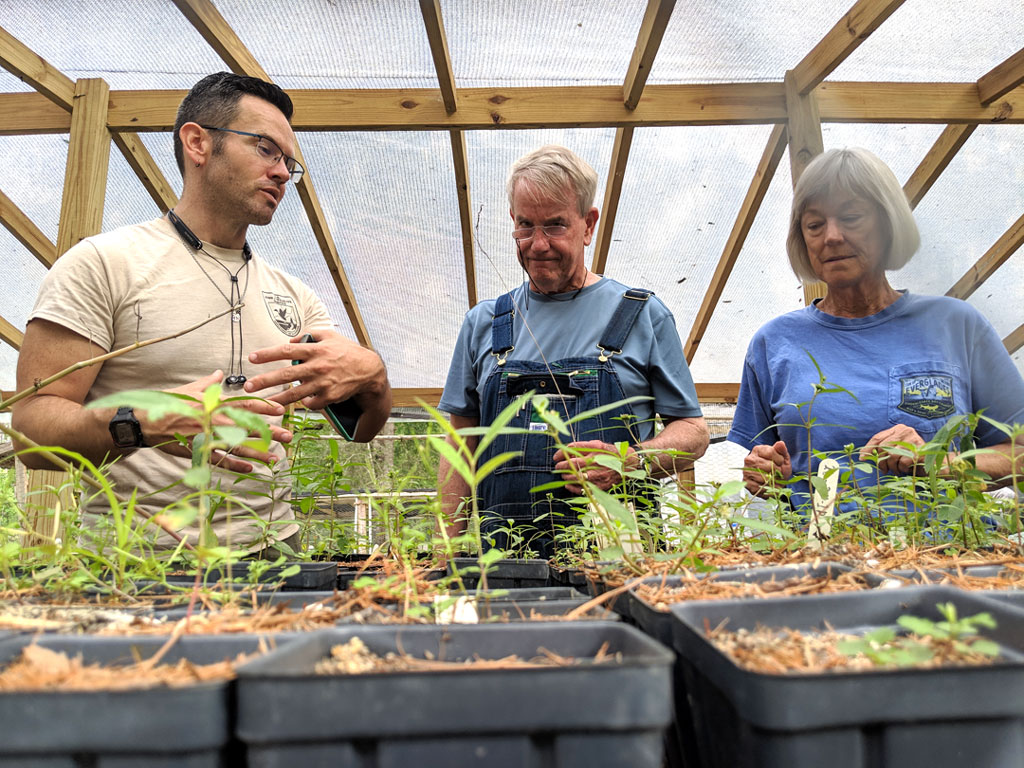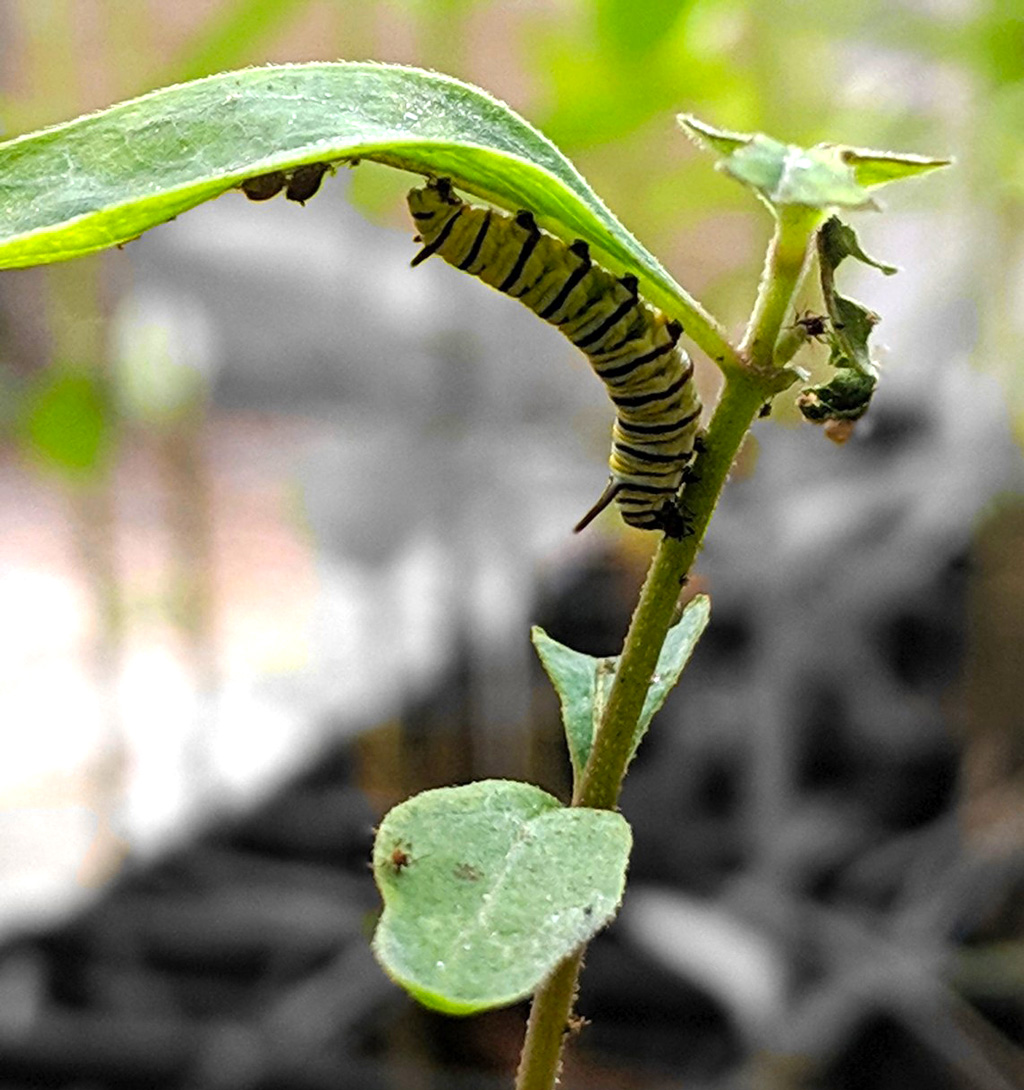Milkweed workday at St. Marks National Wildlife Refuge
Article by Liz Schold, Great Florida Birding Trail Coordinator, Florida Fish & Wildlife Conservation Commission. This article is reprinted with the permission of the Florida Fish & Wildlife Conservation Commission from the June 2019 Kite Tales newsletter. It features a project led by Panhandle Wildflower Alliance member Scott Davis, who has been instrumental in propagating native milkweeds to replenish wild populations.

Last month we had the pleasure of lending a helping hand with the milkweed restoration initiative at St. Marks National Wildlife Refuge in Wakulla County. Along with a team of dedicated volunteers who sometimes refer to themselves as the “Milkweed Mafia,” we scrubbed pots, weeded beds of seedlings, and filled trays with soil that would soon hold precious milkweed seeds collected from the wild. Milkweeds are the host plant for our beloved monarch butterfly, whose caterpillars have co-evolved with the plant. One of milkweed’s defenses against predation is a toxic chemical compound produced within its leaves to deter herbivores. Monarch caterpillars, however, can consume the leaves and the toxin safely, which makes them taste terribly bitter to would-be predators who quickly learn to avoid these brightly striped little larvae.
U.S. Fish and Wildlife Service Ranger Scott Davis has been working on the milkweed restoration initiative since 2015, when he started with a single greenhouse table of seedlings. Since then he has been scouring the state for native milkweed populations and bringing seeds back to the refuge to propagate. He estimates that 300,000 plants have been grown here, which have been planted as part of restoration projects at state parks, state forests and national wildlife refuges across the state. It is no easy task to grow these plants, either. Of the 21 species of milkweed native to Florida, only a handful readily take to being grown in nurseries or backyard gardens. In one of the raised beds outside the greenhouse, sandhill milkweed (Asclepias humistrata) is being grown successfully, but it was difficult to spot at first. This species grows best in sandy soils like those found in scrub and sandhill habitat, and seedlings grow best when they are near other native plants. Scott knelt down and searched under the clumps of native grass, and sure enough, the small milkweeds with their characteristic pale-pink leaf veins were visible underneath. This planting method isn’t practical for large-scale nursery propagation however, so Scott and his team are researching different soil mixtures that can be used to grow these plants from seed more easily and efficiently. Sure enough, inside the greenhouse, tiny A. humistrata are peeking out of flats of soil, reaching up towards the sun.

If it is so tricky to grow these native milkweeds, then why are we going to all the trouble of raising them? The answer lies in the importance of biodiversity. As Scott told us, “Without a diversity of different milkweed species, you only have one species here that can grow in a wetland or another species here that can grow in an upland; you need to have both. Also, typically as one milkweed species is going down for the year another species is emerging.” This diversity of milkweeds creates a connected patchwork of viable host species across the landscape and across the seasons, which is particularly important for monarchs as they complete their annual migration from Mexico to Canada and back.
We also learned that milkweed isn’t the only key to a successful monarch lifecycle. “People tend to plant wildflowers and no larval host species, or vice versa. You need food for the juveniles and you need food for the adults,” said Scott as he gestured to a bed of native wildflowers with ample nectar to support adult butterflies. They aren’t just important to monarchs but serve as an important resource to pollinator species, and by proxy to us. As Scott told us, “We’re very lucky that these insects, as they pollinate their favorite flower species, also like to go hang out on our vegetables and fruit trees. A lot of people don’t realize that when your vegetables and fruit trees are done flowering, that bug is not going to be able to hang around until the following year to take care of your plants again unless you have these other plants flowering.”
This incredible program would not be possible without the support of dedicated volunteers, whose passion for this project shone through as they carefully weeded around the tiny milkweed plants and diligently scrubbed pots. “It’s so sad to me that we’ve lost so much habitat, but the general public is becoming more aware of our natural pollinators and our urban greenspaces,” said Molly, a Master Gardener and refuge volunteer. “We want to be able to provide them native plants, so all of the research that Scott and his team are doing here is amazing.”
If you are interested in learning more about volunteering, you can visit their Friends of St. Marks National Wildlife Refuge volunteer page. And don’t forget to check out FWC’s Wings Over Florida listing recognition program as you learn more about our native butterfly species!
